工程电磁场
- 格式:pdf
- 大小:3.51 MB
- 文档页数:38


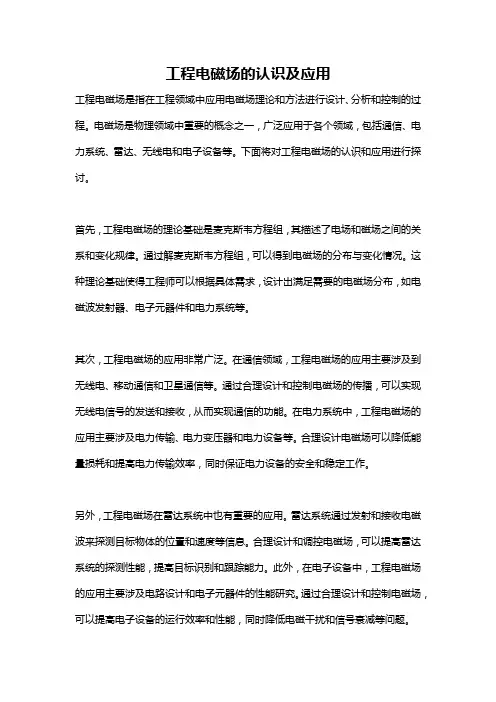
工程电磁场的认识及应用工程电磁场是指在工程领域中应用电磁场理论和方法进行设计、分析和控制的过程。
电磁场是物理领域中重要的概念之一,广泛应用于各个领域,包括通信、电力系统、雷达、无线电和电子设备等。
下面将对工程电磁场的认识和应用进行探讨。
首先,工程电磁场的理论基础是麦克斯韦方程组,其描述了电场和磁场之间的关系和变化规律。
通过解麦克斯韦方程组,可以得到电磁场的分布与变化情况。
这种理论基础使得工程师可以根据具体需求,设计出满足需要的电磁场分布,如电磁波发射器、电子元器件和电力系统等。
其次,工程电磁场的应用非常广泛。
在通信领域,工程电磁场的应用主要涉及到无线电、移动通信和卫星通信等。
通过合理设计和控制电磁场的传播,可以实现无线电信号的发送和接收,从而实现通信的功能。
在电力系统中,工程电磁场的应用主要涉及电力传输、电力变压器和电力设备等。
合理设计电磁场可以降低能量损耗和提高电力传输效率,同时保证电力设备的安全和稳定工作。
另外,工程电磁场在雷达系统中也有重要的应用。
雷达系统通过发射和接收电磁波来探测目标物体的位置和速度等信息。
合理设计和调控电磁场,可以提高雷达系统的探测性能,提高目标识别和跟踪能力。
此外,在电子设备中,工程电磁场的应用主要涉及电路设计和电子元器件的性能研究。
通过合理设计和控制电磁场,可以提高电子设备的运行效率和性能,同时降低电磁干扰和信号衰减等问题。
除了这些方面外,工程电磁场还可以应用于医学领域、冶金和材料领域等。
在医学领域,工程电磁场的应用主要涉及磁共振成像、生物电信号检测和治疗等。
通过合理设计和控制电磁场,可以对人体进行非侵入式检测,从而实现疾病的早期诊断和治疗。
在冶金和材料领域,工程电磁场的应用主要涉及熔炼和热处理等。
通过合理设计和控制电磁场,可以提高熔炼过程的能量利用效率和材料的质量。
总之,工程电磁场是工程领域中非常重要的基础理论和工具之一,广泛应用于各个领域。
通过合理设计和控制电磁场,可以实现特定需求下的电磁场分布,从而满足各种应用需求。
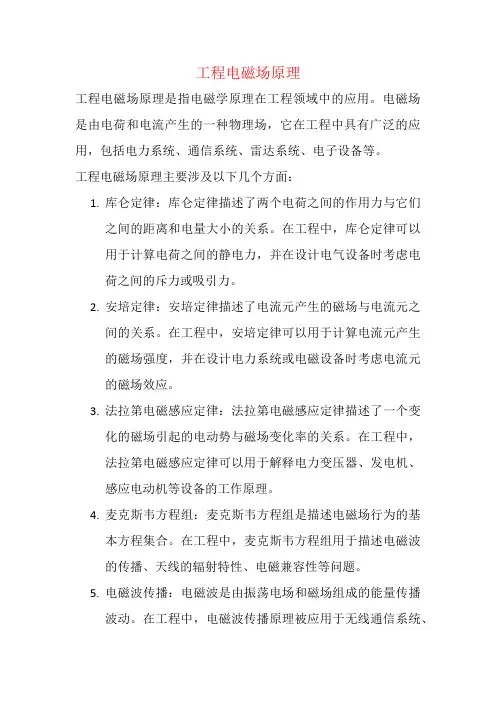
工程电磁场原理
工程电磁场原理是指电磁学原理在工程领域中的应用。
电磁场是由电荷和电流产生的一种物理场,它在工程中具有广泛的应用,包括电力系统、通信系统、雷达系统、电子设备等。
工程电磁场原理主要涉及以下几个方面:
1.库仑定律:库仑定律描述了两个电荷之间的作用力与它们
之间的距离和电量大小的关系。
在工程中,库仑定律可以
用于计算电荷之间的静电力,并在设计电气设备时考虑电
荷之间的斥力或吸引力。
2.安培定律:安培定律描述了电流元产生的磁场与电流元之
间的关系。
在工程中,安培定律可以用于计算电流元产生
的磁场强度,并在设计电力系统或电磁设备时考虑电流元
的磁场效应。
3.法拉第电磁感应定律:法拉第电磁感应定律描述了一个变
化的磁场引起的电动势与磁场变化率的关系。
在工程中,
法拉第电磁感应定律可以用于解释电力变压器、发电机、
感应电动机等设备的工作原理。
4.麦克斯韦方程组:麦克斯韦方程组是描述电磁场行为的基
本方程集合。
在工程中,麦克斯韦方程组用于描述电磁波
的传播、天线的辐射特性、电磁兼容性等问题。
5.电磁波传播:电磁波是由振荡电场和磁场组成的能量传播
波动。
在工程中,电磁波传播原理被应用于无线通信系统、
雷达系统、无线能量传输等领域。
通过理解和应用这些工程电磁场原理,可以帮助工程师设计、分析和优化与电磁相关的系统和设备。
这些原理对于电力工程、通信工程、电子工程等领域的工程实践具有重要的指导作用。
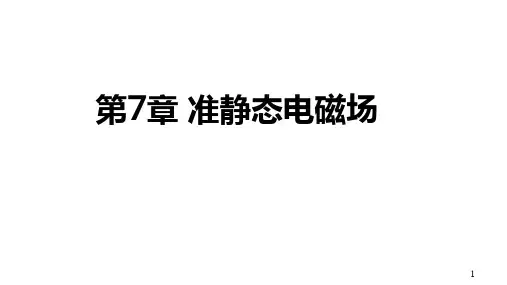

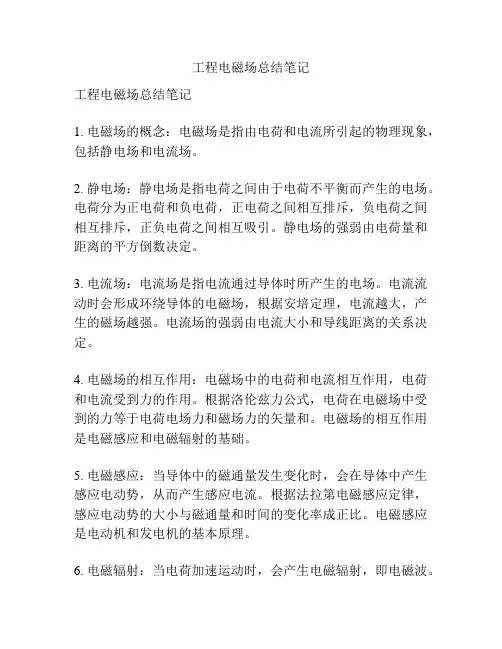
工程电磁场总结笔记
工程电磁场总结笔记
1. 电磁场的概念:电磁场是指由电荷和电流所引起的物理现象,包括静电场和电流场。
2. 静电场:静电场是指电荷之间由于电荷不平衡而产生的电场。
电荷分为正电荷和负电荷,正电荷之间相互排斥,负电荷之间相互排斥,正负电荷之间相互吸引。
静电场的强弱由电荷量和距离的平方倒数决定。
3. 电流场:电流场是指电流通过导体时所产生的电场。
电流流动时会形成环绕导体的电磁场,根据安培定理,电流越大,产生的磁场越强。
电流场的强弱由电流大小和导线距离的关系决定。
4. 电磁场的相互作用:电磁场中的电荷和电流相互作用,电荷和电流受到力的作用。
根据洛伦兹力公式,电荷在电磁场中受到的力等于电荷电场力和磁场力的矢量和。
电磁场的相互作用是电磁感应和电磁辐射的基础。
5. 电磁感应:当导体中的磁通量发生变化时,会在导体中产生感应电动势,从而产生感应电流。
根据法拉第电磁感应定律,感应电动势的大小与磁通量和时间的变化率成正比。
电磁感应是电动机和发电机的基本原理。
6. 电磁辐射:当电荷加速运动时,会产生电磁辐射,即电磁波。
电磁波具有电场和磁场的振荡,可以在真空中传播。
电磁辐射是无线通信和无线电广播的基础。
7. 电磁场的应用:工程电磁场的应用广泛,包括通信、雷达、无线电、电视、计算机等。
通过电磁场的相互作用,可以实现信息的传输和处理。
工程电磁场学是工程学、物理学和电子学等学科的重要基础。
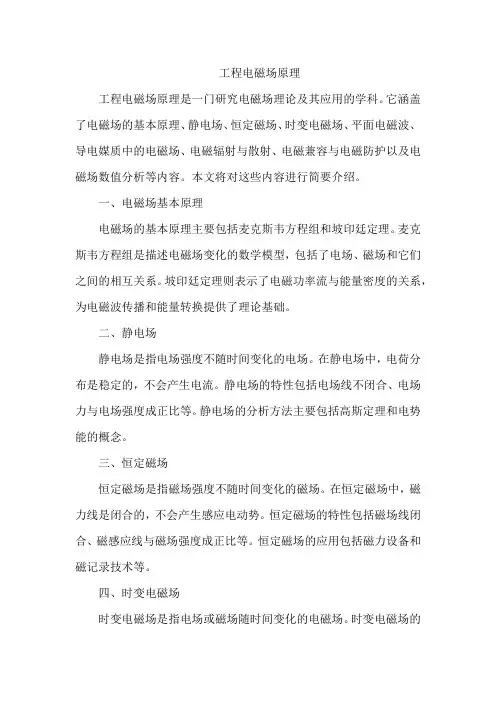
工程电磁场原理工程电磁场原理是一门研究电磁场理论及其应用的学科。
它涵盖了电磁场的基本原理、静电场、恒定磁场、时变电磁场、平面电磁波、导电媒质中的电磁场、电磁辐射与散射、电磁兼容与电磁防护以及电磁场数值分析等内容。
本文将对这些内容进行简要介绍。
一、电磁场基本原理电磁场的基本原理主要包括麦克斯韦方程组和坡印廷定理。
麦克斯韦方程组是描述电磁场变化的数学模型,包括了电场、磁场和它们之间的相互关系。
坡印廷定理则表示了电磁功率流与能量密度的关系,为电磁波传播和能量转换提供了理论基础。
二、静电场静电场是指电场强度不随时间变化的电场。
在静电场中,电荷分布是稳定的,不会产生电流。
静电场的特性包括电场线不闭合、电场力与电场强度成正比等。
静电场的分析方法主要包括高斯定理和电势能的概念。
三、恒定磁场恒定磁场是指磁场强度不随时间变化的磁场。
在恒定磁场中,磁力线是闭合的,不会产生感应电动势。
恒定磁场的特性包括磁场线闭合、磁感应线与磁场强度成正比等。
恒定磁场的应用包括磁力设备和磁记录技术等。
四、时变电磁场时变电磁场是指电场或磁场随时间变化的电磁场。
时变电磁场的分析方法主要包括波动方程和位函数的概念。
时变电磁波的传播速度等于光速,具有频率域的连续性和能量传递方向性等特点。
时变电磁波的应用包括无线通信、雷达探测和电磁成像等。
五、平面电磁波平面电磁波是指电场和磁场在空间中以波的形式传播的电磁波。
平面电磁波具有等相位面和等振幅面的特点,可以沿某一方向传播。
平面电磁波的分析方法主要包括波动方程和傅里叶分析等。
平面电磁波的应用包括卫星通信和电视广播等。
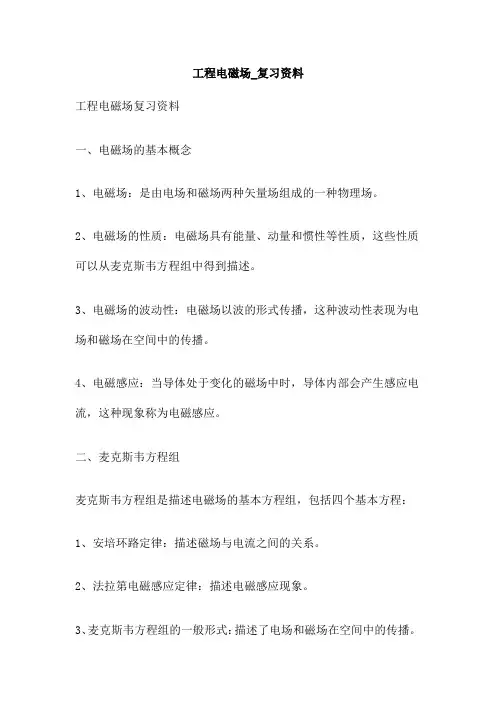
工程电磁场_复习资料工程电磁场复习资料一、电磁场的基本概念1、电磁场:是由电场和磁场两种矢量场组成的一种物理场。
2、电磁场的性质:电磁场具有能量、动量和惯性等性质,这些性质可以从麦克斯韦方程组中得到描述。
3、电磁场的波动性:电磁场以波的形式传播,这种波动性表现为电场和磁场在空间中的传播。
4、电磁感应:当导体处于变化的磁场中时,导体内部会产生感应电流,这种现象称为电磁感应。
二、麦克斯韦方程组麦克斯韦方程组是描述电磁场的基本方程组,包括四个基本方程:1、安培环路定律:描述磁场与电流之间的关系。
2、法拉第电磁感应定律:描述电磁感应现象。
3、麦克斯韦方程组的一般形式:描述了电场和磁场在空间中的传播。
4、高斯定律:描述了电荷在空间中的分布。
三、电磁场的边界条件电磁场在两种不同媒质的分界面上会发生反射和折射等现象,这些现象可以用边界条件来描述。
边界条件包括:1、电场强度和磁场强度在分界面上的连续性。
2、电位移矢量和磁感应强度在分界面上的连续性。
3、分界面上没有电荷堆积。
四、电磁场的能量和动量电磁场具有能量和动量,这些量可以用以下公式计算:1、电磁场的能量密度:W=1/2(E^2+B^2)2、电磁场的动量密度:P=E×B3、电磁场的能量流密度:S=E×H五、电磁场的波动性电磁场以波的形式传播,这种波动性可以用波动方程来描述。
波动方程的一般形式为:∇×E=ρ/ε,∇×H=J/εc^2,其中ρ和J分别为电荷密度和电流密度,ε为真空中的介电常数,c为光速。
六、电磁场的散射和衍射当电磁波遇到障碍物时,会发生散射现象;当电磁波通过孔洞或缝隙时,会发生衍射现象。
这些现象可以用费马原理和基尔霍夫公式来描述。
管理学复习资料马工程版一、管理学概述1、管理学定义:管理学是一门研究管理活动及其规律的科学,旨在探索如何有效地组织、协调和控制人的行为,以实现组织目标。
2、管理学的发展历程:管理学作为一门独立的学科,经历了古典管理理论、行为科学理论、现代管理理论等多个发展阶段。
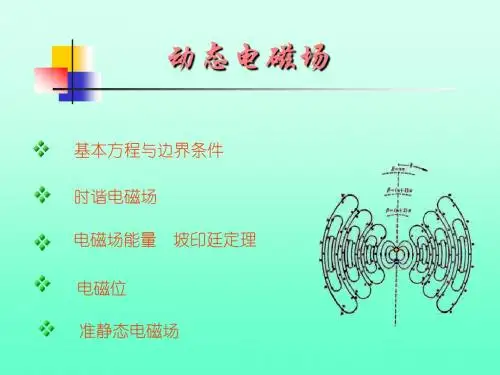

工程电磁场课程概述
工程电磁场课程是电气工程学科中的一门重要专业基础课程,主要介绍电磁场的基本原理、概念、分析方法及应用。
该课程的目标是培养学生掌握电磁场的基本理论,并能够运用这些理论解决实际工程问题。
课程的主要内容包括:静电场、恒定磁场、时变电磁场、麦克斯韦方程组等基本理论,以及电磁波的传播、辐射和散射等。
同时,还会涉及一些与电磁场相关的实际应用,如电力系统的电磁场问题、电磁兼容问题、雷达和通信系统中的电磁场问题等。
工程电磁场课程的教学重点在于让学生理解电磁场的本质,掌握其基本理论和数学分析方法,并能够灵活运用这些知识解决实际问题。
在教学过程中,教师会通过课堂讲解、实验演示和课程设计等多种方式,帮助学生加深对电磁场理论的理解和掌握。
该课程对于电气工程学科的学生来说是必不可少的,因为它不仅涉及到电机、电力系统、通信和控制等领域的基础知识,也是后续学习信号处理、微波技术、电磁兼容等课程的基础。
同时,工程电磁场理论在电力电子、新能源、生物医学工程等领域也有着广泛的应用。
总的来说,工程电磁场课程是一门理论和实践相结合的课程,它要求学生掌握扎实的数学和物理基础,同时也需要学生具备一定的实验技能和解决实际问题的能力。
通过该课程的学习,学生可以更好地理解电气工程学科的内涵,并为未来的学习和职业发展打下坚实的基础。
工程电磁场论文(1)工程电磁场论文工程电磁场是应用电磁学的一个分支,它研究电场和磁场在电气设备和系统中的应用。
工程电磁场的研究内容包括电磁场的产生、传播、辐射、耦合、屏蔽等方面,广泛应用于电力系统、通信系统、雷达系统、计算机系统等领域。
本文将以工程电磁场为主题,从以下几个方面进行探讨。
一、电磁场的基本概念电磁场包括电场和磁场两个方面,电场是由电荷所产生的一种物理场,而磁场则是由电流所产生的物理场。
电场和磁场是密切联系的,它们的关系由麦克斯韦方程组描述。
麦克斯韦方程组是电磁学的基本方程组,可以用来描述电磁场的起源、传播和相互作用。
二、工程电磁场的应用工程电磁场的应用非常广泛,特别是在电力系统和通信系统方面。
在电力系统中,电磁场的应用包括输电线路的设计和运行、变压器的设计和运行等方面。
在通信系统中,电磁场的应用则包括天线的设计和运行、无线电通信系统的设计和运行等方面。
此外,工程电磁场还应用于雷达系统、计算机系统、医学成像系统等领域。
三、电磁场的数值计算方法电磁场的数值计算方法可以分为有限元法、边界元法、时域有限差分法、时域积分方程法等多种。
这些方法的基本原理是根据麦克斯韦方程组进行求解,并通过数值建模和离散化来提高计算精度和计算效率。
其中,有限元法是目前最为常用的一种方法。
四、电磁场的辐射和相互作用电磁场的辐射和相互作用是工程电磁场研究的关键问题之一。
辐射是指电磁波在空间中的传播,而相互作用则是指不同的电磁场在空间中的相互影响。
这些问题的研究对于电磁场的应用和控制具有非常重要的作用。
总体而言,工程电磁场是应用电磁学的一个重要领域,它在现代化建设、信息技术、医疗技术等方面都有广泛的应用。
通过深入探讨电磁场的基本概念、应用、数值计算方法和辐射和相互作用,可以更好地理解工程电磁场的特性和规律,为电力系统、通信系统等工程领域的设计和运行提供更好的技术支持。
如何描述线1周围的用来决定对线2作用力的力场?Note that in the third case (perpendicular currents), I2 is in the same direction as H, so that their cross product (and the resulting force) is zero. The actual force computation involves a different field quantity, B, which is related to H through B = μ0H in free space. This will be taken up in a later lecture. Our immediate concern is how to find H from any given current distribution.第三种情况,磁场与电流平行,叉乘=0特别注意与距离的平方成反比, 而且叉矢量指向纸内(右手螺旋法则决定)Note the similarity to Coulomb’s Lawa point charge of magnitude dQ1at Point 1 would generate electric field at Point 2 given by:The units of H are [A/m]To determine the total field arising from the closed circuit path,we sum the contributions from the current elements that make upthe entire loop, orThe contribution to the field at P from any portion of the current will be just the above integral evalated over just that portion...and so the differential current quantity thatappears in the Biot-Savart law becomes:The magnetic field arising from a currentsheet is thus found from the two-dimensionalform of the Biot-Savart law:of three-dimensional current elements, and so the Biot-Savartand so..so that:Integrate this over the entire wire:..after carrying out the cross productExample: concludedfinally:Current is into the page.Magnetic field streamlinesare concentric circles, whose magnitudesdecrease as the inverse distance from the 线是如何画?(力线疏密反应强如何画?定值/ρ 2,所以,磁力线的间隔怎么画?..after a few additional steps (see Problem 7.8), we find:carry out the cross products to find:but we must include the angle dependence in the radialunit vector注意:rho的单位矢量不是常量!!!with this substitution, the radial component will integrate to zero, meaning that all radial components will cancel on the z axis. rho分量消了,仅仅z分量Note the form of the numerator: the product ofthe current and the loop area. We define this asthe magnetic moment:环可定义磁矩似偶极矩的定义横向涡旋磁场路径a和b的磁场环流= 总电流I路径c的磁场环流= 总电流I的一部分ρso that:as before.solid conductors that carry equal and oppositecurrents, I.The line is assumed to be infinitely long, and thecircular symmetry suggests thatφ-directed, and will vary only with radiusOur objective is to find the magnetic fieldfor all values of ρ无限长内外导体等量异向电流仅沿rho变化的phi向磁场求全径向磁场分布导体间磁场内导体可看作无限长线电流束考虑1、2处的电流丝产生的磁场叠加仅phi向存在ab间场直接为But now, the current enclosed isor finally:体外的场As the current is uniformly distributed, and since wehave circular symmetry, the field would have tobe constant over the circular integration path, and so itmust be true that:+外导体圈内反向电流百分比..and so finally:同轴线磁场强度的径向分布s circuital law to the path we find:In other words, the magnetic field is discontinuous across the current sheet by the magnitude of the surface current density.生的磁场(续)电场的均匀分布If instead, the upper path is elevated to the line between and , the same current is enclosed and we would havefrom which we conclude thatconstant in each region(above and below the current plane)a N is the unit vector that is normal to thecurrent sheet, and that points into the region inwhich the magnetic field is to be evaluated.引申为等效电流aN X H = aN X (0.5KXaN)=0.5KKHHKWe will now use this result as a building blockto construct the magnetic field on the axis ofa solenoid --formed by a stack of identical currentloops, centered on the z axis.contribution to the total field from a stack of N closely-spacedloops, each of which carries current I . The length of the stack so therefore the density of turns will be N/d.Now the current in the turns within a differential length, dz , will bez -d/2d/2so that the previous result for H from a single loop:now becomes:in which z is measured from the center of the coil,where we wish to evaluate the field.We consider this as our differential “loop current ”z-d/2d/2长螺线管的场近似z-d/2d/2We now have the on-axis field at the solenoid midpoint (z = 0):Note that for long solenoids, for which , theresult simplifies to:( )This result is valid at all on-axis positions deep within long coils --at distances from each end of several radii.d/2Therefore:In other words, the on-axis field magnitude near the center of a cylindricalcurrent sheet, where current circulates around the z axis, and whose lengthis much greater than its radius, is just the surface current density.Solenoid Field --Off-Axis螺线管非轴线上的场用安培环路定律来求解:The illustration below shows the solenoid cross-section, from a lengthwise cut through thethe windings flows in and out of the screen in the circular current path. Each turn carries currentfield along the z axis is NI/d as we found earlier.Where allowance is made for the existence of a radial H component,The radial integrals will now cancel, because they are oppositely-directed, and because in the long coil,Conclusion: The magnetic field within a long solenoid is approximately constant throughout the coil cross-section, and is H z = NI/d.绕组被建N个流回路,每个承载电流I.镯形环形绕组,横截面可是圆形或其他任意形状individual windings. Under this condition, we would assume:This approximation improves as the density of turns gets higher(using more turns with finer wire).Ampere’s Law now takes the form:so that….Performing the same integrals over contours drawnin the regions or willlead to zero magnetic field there, because no currentis enclosed in either case. 环外场= 0Consider a sheet current molded into a doughnut shape, as shown.The current density at radius crosses the plane in the zdirection and is given in magnitude byleading to…inside the toroid…. and the field is zero outside as before.where:基于Taylor 级数展开的近似And therefore:向路径段的贡献The contribution from the opposite side is:Note the path directions as specified in the figure, andhow these determine the signs used .This leaves the left and right sides…..…and the contribution from the left side (path 4-1) is:The next step is to add the contributions of all four sides to find the closed path integral:合路径积分and using our previous results, the becomes:Dividing by the loop area, we now have:The expression becomes exact as the loop areaapproaches zero:其他方向的结果类似:The same exercise can be carried with the rectangular loop in the other two orthogonal orientations.下的结果.方向的确定遵循右手螺旋法则:四指指向积分路径方向,大拇指指向旋度方向The curl component in the direction N, normal to the plane of the integration loop is:is taken using the right-hand convention: With fingers of the right hand orientedin the direction of the path integral, the thumb points in the direction of the normal (or curl).An easy way to calculate this is to evaluate the following determinant:which we see is equivalent to the cross product of the del operator with the field:Look these up as needed….…..静磁场的麦克斯韦方程(思考总磁场的形式):同时也是安培环路定律的点形式(微分形式).总电场的形式):(applies to a static electric field) Recall the condition for a conservative field: that is, its closed path integral is zero everywhere.Therefore, a field is conservative if it has zero curlis paritioned into sub-regions, each of small areaThe curl component that is normal to a surface element canWe now apply this to every partition on the surface, and add the results…..cancellation here:Theorem.We now take our previous result, and take the limit asIn the limit, this side becomes the path integral of H over the outer perimeter because all interior paths cancel 等效于外围闭合路径积分In the limit, this sidebecomes the integralof the curl of H over surface S等效于在整个S 上积分两个定律均可直接从纯高等数学的角度直接展开证明)This is a valuable tool to have at our disposal, because it gives us two ways to evaluate the same thing!积分联系起来了Integrate both sides over surface..in which the far right hand side is found from the left hand sideusing Stokes’Theorem. The closed path integral is taken around theperimeter of S. Again, note that we use the right-hand convention inchoosing the direction of the path integral.so we are left with the integral form of Ampere应强度)in which the electric flux density in free space is:and where the free space permittivity ismagnetic flux in units of Webers (Wb):磁通密度(磁感应强度)in free space is:and where the free space permeability is有关。